CAN YOU READ A BOOK WITHOUT WORDS? by Clare Helen Welsh
Since you’ve found yourself here, at Picture Book Den, Isuspect you'll agree with me that picture books are incredible. The best ones, even magical.
Listeningto the rhythm, joining in with the words, trying out voices, pointing to thepictures... the pace, the pauses, the ups and the downs... all work together asthe story unfolds, delivering an ending that make little hands want to read itall over again. Sharing a picture book creates time to talk, to learn, tofeel and explore giving children space to see and hear and respond.
Yes. I am ahuge advocate of picture books and the magic they hold.
But whatabout a book with little or no words? Can they support children’s development?Can they be magical too?
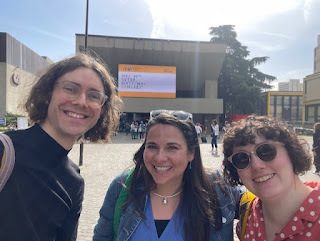
Harry Woodgate, me and Emma Reynolds outside Bologna Book Fair
I recentlyvisited the Children’s Book Fair in Bologna whereI spent quite some time in the Silent Stories Exhibit.The walls were literally lined with wordless wonders – several internal spreadsfrom wordless projects enlarged and framed, and the full books below. In myview, wordless spreads absolutely CAN be as magical as books with words, maybeeven more so.
Here'swhy...
Cercas Gambas by Irene Frigo
There is a chair in themiddle of nowhere. How it ended up there is unknown, but in the end it doesn'teven matter. What is known is that that chair is missing aleg. Not that this makes it any less of a chair, but those who pass by are ledto think that additional support could be useful.
So, the most disparatethings, from baguettes to umbrellas, from footballs to trumpets, are placedlike prosthetics where the front right leg is not there. But baguettes are easyprey for hungry mice, umbrellas attract customers caught in the rain, balloonsfly away and trumpets are made to be blown.
This bookmade me smile. It made me think deeply about the wider world and that the chairwas perhaps a metaphor for something else... and all through the exploration ofa chair with a missing a leg.
Picture books make us think deeply, and without any words!
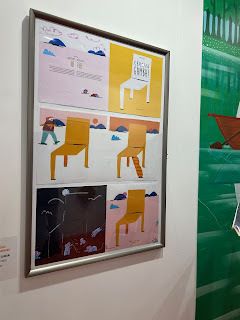
WINDOWS by Lana Alma
This book explores our perception of othersthrough the metaphor of viewing fragments of people's lives through ‘windows.'It shows us how our beliefs shape our understanding, revealing that behind thecurtains of perception, wondrous things might await, and our own monsters maynot be monstrous at all.
This was another thought-provoking story - a simple but memorablewordless book poised to challenge readers and the judgements they make.
Picture books can challenge stereotypes - and they can do it withoutwords.
PIANTALA by Alessia Roselli
This book featured a woodcutter who cuts down trees in the forest,disturbing the peace and balance in nature. But the woodcutter has a change ofheart when they have a close encounter with a wolf who forces them to takerefuge in a tree - nature bites back!
This wordless story tells us the importance of respecting theenvironment in which we live, which gives so much to us every day, withoutasking for anything in return.
Wordless picture books have the power to inspire their readers to careand respect nature... and yet they have no words.


IL CORAGGIODI SUSY by Betty
Susy is a smart, curiouslittle girl. She is happy in the house she grows up, and in her village, butwith her fears also grow like a big black shadow that follows her everywhere.Her fear becomes bigger every day. When Susy notices the ugly monsterbehind her she is not afraid, she goes to the mirror to look at it better, eventhough it is really scary up close.
This was an empowering - andat times, terrifying - story of courage and self-belief.
Wordlesspicture books have the power to portray children's struggles and suggest copingstrategies for difficult times.
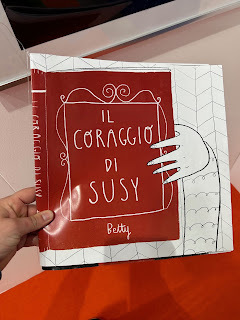
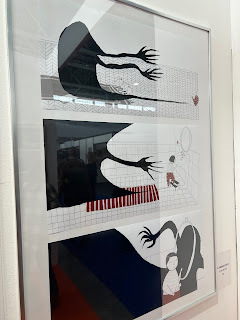
EVERYKINDNESS by Marta Bartolj
I also came across this bookby Marta Bartolj. It's again, completely wordless, and depicts random acts ofkindness across a community in a distinctive and deceptively simple way. There'splenty happening in the foreground and background of the illustrations and whatgoes around comes around for the main character.
Wordless picture books canencourage their readers to think about how their actions affect others.Wordless picture books can inspire empathy.

SENZA FINEby Zongxi Deng
Probably the book that madethe most impact on me, was this one by Zongxi Deng called SenzaFine. As with the other wordless picture books, it was powerful anddeceptively simple, about a man who chooses which animal he wants to bereincarnated as after he passes away. Perhaps not everything disappears. Perhaps something remains...albeit in a different form.
The Silent Storiesexhibition was incredibly popular and at times there were several peoplecrowded around the same book. When I read Senza Fine, I did so withanother lady. We didn't communicate in words - I don't think we spoke the samelanguage - but we made eye contact, we smiled and communicated through bodylanguage as we turned the pages and connected over our love for this book andits impactful end... and all without saying a word.
Wordlesspicture books create connection, even without words.

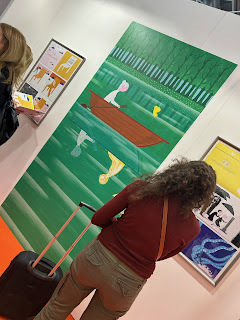
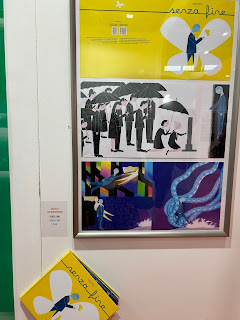
So, can you read a wordless picture?
Absolutely! You can!
Pictures books tell stories with or without theaddition of words. And they do this through pictures.
Visual literacy is the skill of inferring meaning fromimages - analysing them, interrogating them, making sense of them. Wordlesspictures books still have characters, plots, crisis points, resolutions,themes... you can ask yourself them same who, what, where, when, why questionsas you would with any other picture book... because they have pictures doing the work and telling the story.
Picture books are praised for the high quality talkthey provide. A wordless picture book can be even more powerful,with even more opportunities to grow discussion and to askquestions. And this is all thanks to the enchanting, terryfying, inspiring, beautiful, thoughtful, magical world of the illustrations.
OK, so you can't listen to the rhythm of the words or join inwith the refrain and voices...
But you can make up yourown and that might be better!
You can still feel thepace, the pauses, the ups and the downs... absorbing the story visually as itstory unfolds. Sharing a wordless picture book still createstime to talk, to learn, to feel and explore through giving children spaceto see and hear and respond.
In fact, given that there’sno right or wrong way to tell a wordless story, it can lead to more talktime for co-creating the story together. There’s more opportunityto explore the detail, notice the nuance and challenging readers to lookbeneath the surface and bring their own experiences, attitudes, emotions andideas to the characters and plot.
In my opinion, wordlesspicture books are a challenge, a joy, a wonder. The ones I read at the SilentStories exhibit, empowered me, inspired me, made me smile, made me think andbrought me connection. When a story is shared, be it through listening, speaking, writing, we are all richer for it - be it through words, pictures or a combination.
These ideasare exactly what I was channelling when I wrote Moon Bear –an almost wordless, enchantingly illustrated picture bookabout a child called Ettie who is afraid of the dark. Ettie meets a bear is whoafraid of the light, and together they learn about the magic of thenight. Here I amholding a physical copy at the Quarto stand in Bologna! It's a sensationalproduction and has been created with my co-collaborators - illustratorCarolina T. Godina, editor Claire Grace, designer Karissa Santos, and publisherFrances Lincoln.
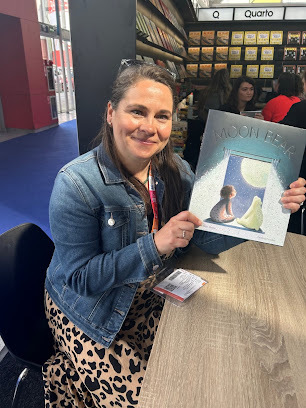
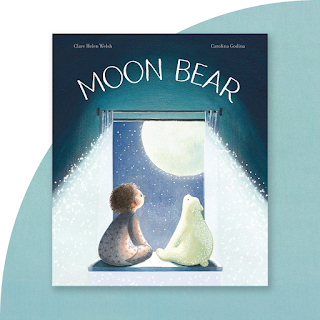
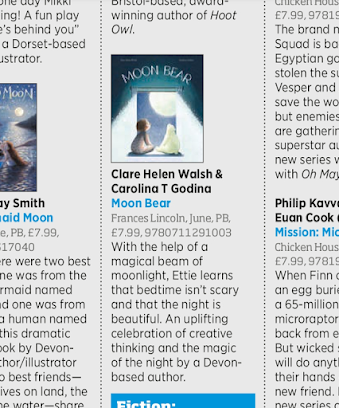
I’m lookingforward to sharing the magic of wordless picture books with readers andfamilies when Moon Bear publishes later thismonth. When shared with children, wordless picture books can inspire confidence, helping them feel confident to read at their own pace and making them an active participant in the storytelling. I’m hoping that the story sessions I run will be even more powerful,especially with the children who do not write or who do not want to write. I’vegot some workshop ideas that I’m really excited about. Will less words equal more power and more magic? Watch this space!
This leads me nicely into the pitch for my next Picture Book Den article,coming in October.
Can you write a wordless picture book?
Absolutely! You can!
Clare HelenWelsh is a children's writer from Devon. She writes fiction andnon-fiction picture book texts - sometimes funny, sometimes lyrical andeverything in between! Her latest picture book is called 'MoonBear,' illustrated by Carolina T. Godina and published by FrancesLincolm. You can find out more about herat her website www.clarehelenwelsh.com or on Twitter @ClareHelenWelsh . Clare isrepresented by Alice Williams at AliceWilliams Literary and is the founder of #BooksThatHelp.




